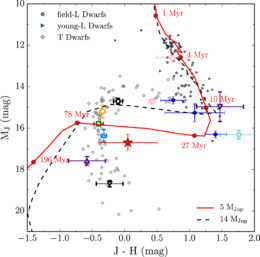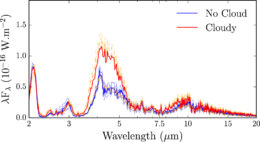Direct imaging of exoplanets was once only possible for the brightest of planets orbiting the dimmest of stars — but improving technology is turning this into an increasingly powerful technique. In a new study, direct-imaging observations of the Jupiter-like exoplanet 51 Eridani b provide tantalizing clues about its atmosphere.
Direct Imaging of 51 Eri b
While transit detections remain the best way to discover large quantities of new exoplanets, direct imaging provides a unique advantage: you can measure the light from the exoplanet itself. With proper constraints on the host star, it therefore becomes possible to measure the spectrum of the planet’s atmosphere.One target for this technique is 51 Eri b, a Jupiter-like exoplanet located roughly 100 light-years away. This object was the first exoplanet directly imaged by the Gemini Planet Imager Exoplanet Survey, a project that used the Gemini Planet Imager (GPI) instrument in Chile to search for exoplanets around 600 young nearby stars.
A team of scientists led by Abhijith Rajan (Arizona State University) has now made new near-infrared observations of 51 Eri b: spectroscopy in the K band using GPI, and photometry in the Ms band with a camera on the Keck I telescope in Hawaii. Rajan and collaborators combined this new data with past observations and modeling to better characterize the 51 Eri b’s properties.

Color–magnitude diagrams for brown dwarfs and imaged exoplanets (click for a closer look). The color of 51 Eri b (marked with red star) places it among late T dwarfs, but it is redder than most comparable-temperature brown dwarfs. The tracks for the L–T transition for two different planet masses are shown. [Rajan et al. 2017]
Cloudy Transition
One intriguing aspect of 51 Eri b is the challenge of determining its spectral type. Though its spectrum is consistent with that of a T dwarf, photometry shows that it’s unusually red for this spectral type. There may be a reason for this, however: clouds.
Rajan and collaborators find that the best fitting models for 51 Eri b’s spectra all have an atmosphere consisting of patchy clouds. This result holds true both for models with the salt and sulfide clouds expected to condense in the atmospheres of mid-to-late T dwarfs, and for models with the iron and silicate clouds common in atmospheres of redder L-dwarfs.
The authors hypothesize that 51 Eri b may be in the process of transitioning from a warmer L-type body to a cooler T-type body. As an L-type planet cools, holes and low-opacity patches appearing in an initially uniform cloud deck could cause the transition of the planet’s spectrum to T-type.
An Unusual Start?

The ten best-fitting cloudy (red) and cloudless (blue) atmospheres over the wavelength range of JWST, illustrating that JWST will likely be able to differentiate between atmospheric models for 51 Eri b. [Rajan et al. 2017]
While much remains to be learned about 51 Eri b, these new results provide an excellent step in the right direction. The authors also show that future observations — such as with the James Webb Telescope — will allow us to further differentiate between models describing this planet. 51 Eri b’s intriguing atmosphere makes it a prime target to revisit as our observational capabilities continue to improve.
Citation
Abhijith Rajan et al 2017 AJ 154 10. doi:10.3847/1538-3881/aa74db



8 Comments
Pingback: partly cloudy exoplanet
Pingback: A Partly Cloudy Exoplanet – Association Copernic
Pingback: Amerikan Gökbilim Derneği (AAS) Bülteni | Günün NASA Görüntüsü
Pingback: Un exoplaneta parcialmente nublado – Observatori Astronòmic
Pingback: Exoplaneta algo nublado « SEDA / LIADA - RedLIADA - Cursos LIADA - Cielo del Mes - Fenómenos Astronómicos - RELEA
Pingback: 51 Eri b con nubes | Sección de Exoplanetas - Planetas extrasolares / LIADA Liga Iberoamericana de Astronomía
Pingback: June 22, 2017 | Colorado Space News
Pingback: Moonetesimals likely form relatively quickly | astrobites